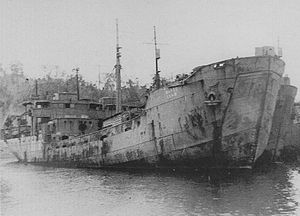The SS-class landing ship (SS艇 or 機動艇, SS-tei or Kidōtei) was a class of amphibious assault ships of the Imperial Japanese Army which served during World War II. The SS meaning are Sensha-Small.[1]
 SS No.19
| |
| Class overview | |
|---|---|
| Name | SS-class landing ship |
| Builders | |
| Operators | |
| Succeeded by | SB-class |
| Subclasses |
|
| Built | 1939–1945 |
| In service | 1939–1947 |
| In commission | 1944–? |
| Planned | over 30 |
| Completed | 18[1] or 21[2] or 22[3] |
| Lost | ? |
| Retired | ? |
| General characteristics SS No.3 class | |
| Displacement | 730 long tons (742 t) gross |
| Length | 65.00 m (213 ft 3 in) overall |
| Beam | 9.50 m (31 ft 2 in) |
| Draught | 2.89 m (9 ft 6 in)Error: has synonymous parameter (help) |
| Draft | 5.65 m (18 ft 6 in)Error: has synonymous parameter (help) |
| Propulsion | |
| Speed | |
| Range | 3,000 nmi (5,600 km) at 13.4 kn (15.4 mph; 24.8 km/h) |
| Capacity | 5 tanks and 170 troops |
| Complement | 40 |
| Armament |
|
Background
editOctober 1938, the IJA employed the Shinshū Maru during their successful amphibious operations at Bias Bay. However, a considerable amount of time was needed to complete the operation owing to the low speed of the landing craft, which resulted in considerable damage to the vessels involved.
The IJA employed the principles of speed and minimum damage to their amphibious warfare operations.
In 1939-1940, the IJA repeated an experiment with Gorō Maru (300 tons gross) and Yorihime Maru (526 tons gross) and after analysing the experiment data placed an order for the prototype Kōryū (later SS No.1).
- The IJN was interested in the second prototype Banryū (later SS No.2). The IJN placed an order for 16 ships. However, thereafter they adopted the No.101-class and the order was cancelled.
Ships in classes
editSS No.1
edit- Kōryū / SS No. 1 (蛟龍, 機動第一号艇)
| Builder | Harima Zōsen Corporation |
| Laid down | 18 July 1941 |
| Launched | 26 January 1942 |
| Completed | 7 April 1942 |
| Displacement | 641 long tons (651 t) gross |
| Length | 53.9 m (176 ft 10 in) overall |
| Beam | 9.00 m (29 ft 6 in) |
| Draught | 3.20 m (10 ft 6 in) |
| Propulsion | 2 × intermediate diesels, 2 shafts, 1,246 bhp |
| Speed | 14.56 knots (16.76 mph; 26.97 km/h) |
SS No.2
edit- Banryū / SS No. 2 (蟠龍, 機動第二号艇)
| Builder | Harima Zōsen Corporation |
| Laid down | 8 August 1942 |
| Launched | 17 May 1943 |
| Completed | 30 July 1943 |
| Displacement | 730 long tons (742 t) gross |
| Length | 63.02 m (206 ft 9 in) overall |
| Beam | 9.60 m (31 ft 6 in) |
| Draught | 4.00 m (13 ft 1 in) |
| Propulsion | 2 × intermediate diesels, 2 shafts, 1,284 bhp |
| Speed | 13.96 knots (16.06 mph; 25.85 km/h) |
| Fate | Sunk in action on 24 September 1944 |
SS No.3 class
edit- Kairyū / SS No.3 (海龍, 機動第三号艇)
- SS No.4, Sunk in action on 12 October 1944
- SS No.5, Sunk in action on 30 November 1944
- SS No.6, Sunk in action on 7 December 1944
- SS No.7
- SS No.8, Sunk in action on 19 November 1944
- SS No.9, Sunk in action on 6 December 1944
- SS No.10, went missing on the night of December 1-2, and lost with all hands after departing Palompon, Leyte. USS Conway, USS Cony, USS Eaton, and USS Sigourney, all ( United States Navy) did report sinking an enemy vessel in the area the convoy would have been in.[4]
- SS No.11
- SS No.12, Sunk in action on 21 January 1945
- SS No.13
- SS No.14, Sunk in action on 22 May 1945
- SS No.15
- SS No.16
- SS No.17
- SS No.18
- SS No.19
- SS No.20
- SS No.21
- SS No.22, Sunk in action on 10 August 1945
See also
editFootnotes
editBibliography
edit- Monthly Armor Modelling special issue, Navy Yard Vol.9 Tora! Tora! Tora! part-2, Dainippon Kaiga (Japan), November 2008
- Rekishi Gunzō, History of Pacific War Vol.37, Support Vessels of the Imperial Japanese Forces, Gakken (Japan), June 2002, ISBN 4-05-602780-3
- Ships of the World No.506, "Kaijinsha"., (Japan), February 1996
- 50 year History of Harima Zōsen, Harima Zōsen Corporation, November 1960